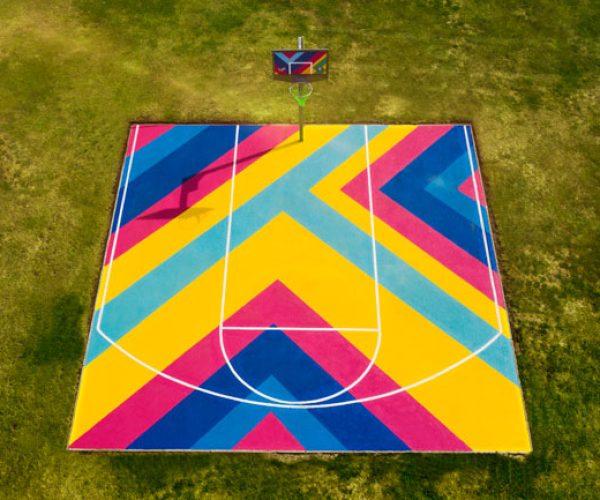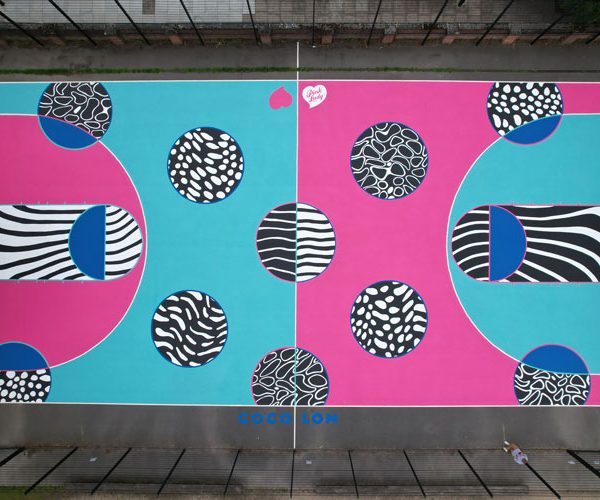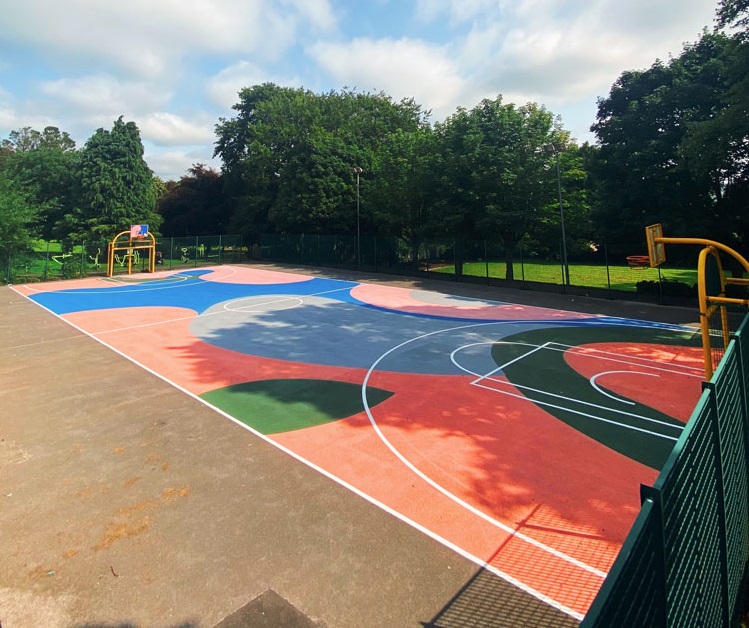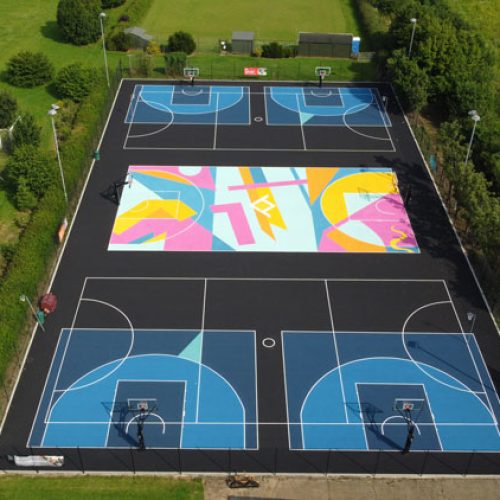September 25, 2025
“A basketball court is a blank canvas,” Gareth Roberts says. “As long as the lines are on there, you can do pretty much anything.” Roberts is a basketball player turned designer – he used to play for England’s under 18 team before pursuing a career in packaging design. Four years ago, he founded Project in the Paint, with the aim of revamping local courts and engaging people with the sport. “Design impacts the way people react,” he adds. “And you can play on that knowledge with basketball.”
While basketball is one of the most popular sports in the UK, funding often doesn’t match up, according to Roberts. “There are so many under loved courts in the UK,” he says. Art courts, as they’re sometimes known, provide a solution to this: repairing surfaces while attracting new players through eye-catching design. So far, Roberts has designed four courts including two in Chelmsford, Essex and another at a university in nearby Writtle.
The art courts have attracted more players and particularly families with younger children, the designer explains. “They might not even have a basketball, they might have a beach ball or a bow-up ball they found in the garden,” he says. “They just want to be engaged with the sport, and maybe never have before.” Roberts estimates that revamped courts last around five years, while they’re relatively easy to maintain (the UK’s rainfall keeps them clean).
As art courts have popped up across the UK – Roberts has advised on courts in South London and Portsmouth – interest has been piqued. While the first court was crowdfunded, Roberts has been offered funding from councils in Essex for more spaces, while a court in London’s Islington was commissioned by apple brand Pink Lady. He is currently in talks with Birmingham City Council, ahead of the 2022 Commonwealth Games.

Roberts considers the sport well-suited to imaginative designs. “I’ve always found basketball to be a more interesting sport – in terms of aesthetics – than any of the others,” he says. “In the 90s specifically, the clothing and culture around basketball was really vibrant and artistic.” The National Basketball Association (NBA) has well-regarded logos, for example. “It’s second nature that people who are engaged in basketball, are also engaged in colour and design,” he adds.
Roberts approached designer Coco Lom for the Islington court, which opened in the summer. “I wanted the court to have a story behind it,” Lom says. In keeping with the Pink Lady brief, she examined apples under the microscope – looking at dried apple pollen and leaves. She then incorporated these shapes and patterns into the design, while also researching how players navigate the court. The court is designed to “echo the energy and the flow of the game,” Lom adds.

She kept a few considerations in mind when designing the space. The graphics could not distract the players, Lom explains. “I made sure I wasn’t interfering with any important lines,” she adds, and these line markings were also redone. The backboards and nets were also revamped, and Lom designed bespoke basketballs. The team also consulted people with learning difficulties and visual impairments to ensure that the courts were accessible for all types of users.
Lom, Roberts and an extended team painted the court by hand. In total, they applied two layers including primer, working from a grid system. One aspect that pleases Lom the most is the flexibility of the redesigned space. “Although it’s a basketball court, there’s potential for other games to be played on the court,” she says, pointing to the circular elements. “I hope that kids and even adults will be able to go on the court and make up their own games.”
Lom recalls how the UK’s bad weather interfered with the design process over the summer – at one point the court resembled a “pink swimming pool” because of heavy rainfall, she says. Roberts is aware that some designers have begun to work with spray paint in an attempt to speed up the process, though he remains committed to the “hands-on element”, believing that it lends the courts an authenticity. “You wouldn’t get Van Gogh coming in and having someone layer base blue before he put his cornflowers on,” he says. “We should approach our work the same way.”

One of the UK’s first art courts was designed in 2018 in Brighton by Lois O’Hara. She was inspired by the work of Project Backboard, an American organisation which revamps courts in the US. It took her a year to organise and she was driven by an ambition to make the spaces “safer” for the local community. “I wanted to make the area safe and to encourage those who wouldn’t usually engage in the sport to try it,” she says.
O’Hara believes her signature style – inspired by curves and organic shapes – is conducive to gameplay. “My creative style is very fluid and it’s really satisfying to see kids and young adults run around the curved shapes and lines,” she says. “I think my work easily inspires movement because it is so organic and versatile.” O’Hara explains that she sometimes creates compositions based on where players spend the most time, thereby encouraging movement through “perfectly-placed curved shapes”.

According to O’Hara, she’s improved in designing art courts since her first project, learning to re-surface the ground before applying the designs which makes them last longer. Most recently, she revealed a perspective-shifting basketball court in Bradford, West Yorkshire. She’s also turned her eye to tennis courts and badminton tables.
This boom in popularity is not limited to the UK. Over the summer, a court in Brooklyn, New York was painted to promote the release of the Space Jam sequel – making the most of the film’s basketball roots (it stars sporting legend LeBron James). But Roberts advises some caution for future branded courts. “It would be easy for a big brand to come in and sponsor a court and require their logo all over, but I don’t think it feels right to go into an underprivileged neighbourhood and do a Louis Vuitton court,” he says. “It seems tasteless to me.”

London Sharks – © All Rights Reserved | Designed with love, coded with care by Web Online Design